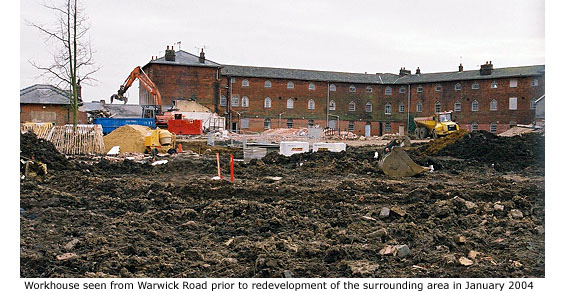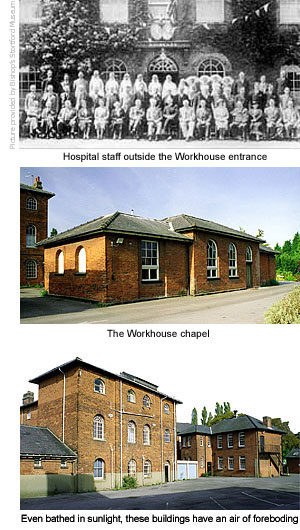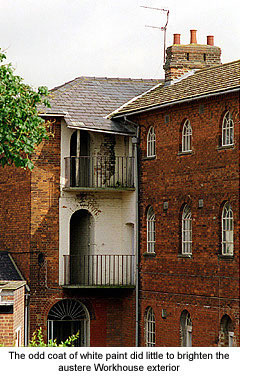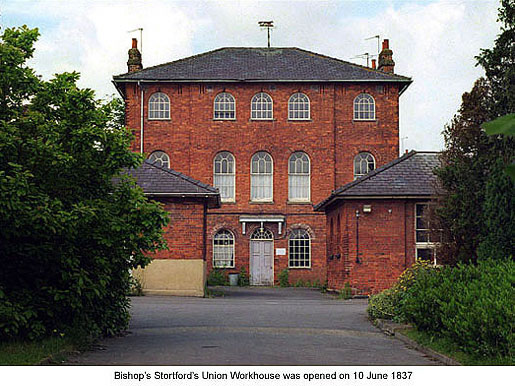|
By January 2004, the original Herts and Essex hospital at Haymeads Lane had been razed to the ground and the site cleared for redevelopment. The only structure left intact amid the bleak clay landscape was Bishop's Stortford's former Workhouse; uncluttered by surrounding buildings its true size now apparent for the first time in over 60 years. From the distant vantage point of Warwick Road it was now possible to see and imagine just how awful the prospect of staying in this austere Victorian Institute must have been for those whose only alternative it was.
Workhouses were originally conceived to house the poor of towns and villages, but most occupants were only homeless through social stigma as opposed to poverty – many being mentally disabled or illegitimate. Workhouses were soul destroying places, deliberately designed to be unattractive in order that inmates should not abuse their charity.

Most, like this one, were purposefully sited a suitable distance from town centres so as not to cause offence to local inhabitants. Planners of that time could have had little idea that their siting of this workhouse would benefit 21st century property developers – the 'suitable distance from town' now being termed 'sought after'
Access to the new housing development at Haymeads Lane follows the same route once used by paupers to enter the workhouse, though some reminders of that time were quick to disappear when the contractors' moved in. These included the large timber supports of the workhouses’s long-gone entrance gates and lodge house that stood alongside them, and the short stretch of road that had led paupers to its ‘reception’ centre. Their replacement was a reception area of the 21st century, suitably furnished with potted palms and 'welcoming' faces eager to persuade potential home buyers to part with their money.
Redevelopment of the entire site was completed in late 2006, by which time 230 new properties had been built and the Grade II listed workhouse, as well as associated Rutherford House, had been renovated and refurbished to accommodate 33 spacious apartments. The general structure and layout of both buildings was retained, including the red-brick Victorian exterior of the workhouse with its archetypal (albeit now double-glazed) windows. But cosmetic changes only disguise this former Institution’s history. New occupants will live in a comfort never imagined by past inmates and one can only wonder what they might think of it all should they now be looking on.
Most photographs of the workhouse on these pages were taken in 2001 when much of the building was still used by NHS administration staff. They give some idea of how it looked for almost 170 years.
See MORE PICTURES for photographs of the finished development
A workhouse with accommodation for up to 70 local paupers had been in existence in Bishop's Stortford since at least 1776, and continued to operate as such until 26 March 1835. At that time the Poor Law Amendment Act of 1834 came into force (locally), changing its status to Union Workhouse and therefore obligated to take in paupers from twenty parishes in East Hertfordshire and West Essex.
Representing these parishes and seeing to the running of the workhouse was a board of twenty-seven Guardians, who soon realised that much larger premises were required. For what had been adequate accommodation for local paupers, certainly wasn't big enough to house paupers from 20 parishes. In 1836, with the aid of a bank loan, the building of a new Union workhouse at Haymeads went ahead. Extra funds were raised by selling Hockerill workhouse at auction, fetching £1,000, but somes expense was spared when the Guardians purchased the entire contents of the old workhouse to furnish the new at a cost of £185. 2s. (See Guide 9 – See Hockerill Street)
 Designed by T.L. Evans, on the popular hexagonal or ‘Y-plan’ layout and built by a local building firm at a cost of £9,137, the new Union Workhouse was completed on 10 June 1837. An additional amount of £23. 5s. was later approved for the building of a bell tower and bell for the purpose of summoning paupers to their meals. Designed by T.L. Evans, on the popular hexagonal or ‘Y-plan’ layout and built by a local building firm at a cost of £9,137, the new Union Workhouse was completed on 10 June 1837. An additional amount of £23. 5s. was later approved for the building of a bell tower and bell for the purpose of summoning paupers to their meals.
The 4 acre site comprised of a separate chapel, Boardroom, three accommodation blocks and exercise yards, but its size was increased in 1842 to accommodate, in total, about 400 inmates. Professional staff were few: a nurse also acted as a midwife and paupers did the ancillary work guided by a resident porter. There was a ward for the insane and a padded room for the violent, while those with serious infections were housed in a small cottage. A wooden hut, also used as an isolation unit, was often so crowded that food had to be kept in the bathroom.
With so many inmates, sanitation left a lot to be desired. Initially, raw sewage was pumped from an open trough only a short distance from the building, a situation not resolved until the 1870s when a sewage farm was opened on 42 acres of land at nearby Beldams Lane. That same decade, several outbreaks of smallpox in the area prompted the rapid building of an isolation hospital at nearby Hallingbury Road. Labourers did the work on overtime at a total cost of £480 but the building, a wooden structure built on piles, quickly fell into disrepair and another was erected approximately where Nos 15–19 Haymeads Lane now stand.
The Vagrancy Acts of the late 19th century led to alterations and additional wards in order to cope with new obligations to provide for ‘casuals’ (vagrants), and in 1892 the Guardians purchased a further 13 acres of land at Haymeads to provide occupation for the inmates – growing produce for their own consumption.
 In 1894, Rye Street Cottage Hospital (See Guide 7) was under construction; the same year a medical inquisition was held on the workhouse. With no hospital nearer than Cambridge or London to tend the working class sick, it was concluded the workhouse should also become the local Infirmary and be renamed Haymeads. By that time there were 112 beds for men and women needing medical care as well as a separate fever ward with bedding of flock, feathers and straw according to the case. Water and air mattresses were also available.
In 1894, Rye Street Cottage Hospital (See Guide 7) was under construction; the same year a medical inquisition was held on the workhouse. With no hospital nearer than Cambridge or London to tend the working class sick, it was concluded the workhouse should also become the local Infirmary and be renamed Haymeads. By that time there were 112 beds for men and women needing medical care as well as a separate fever ward with bedding of flock, feathers and straw according to the case. Water and air mattresses were also available.
Undocumented evidence suggests that gas victims of the First World War were brought to the workhouse under cover of darkness, and then rehabilitated in the infirmary wards. This was probably carried out in secret to prevent wide scale knowledge of the use of gas in the trenches of France.
Between 1926 and 1930 the Guardians administered the workhouse from purpose built mock-Tudor style premises at No 2 Hockerill Street. And at about the same time, a report by the County Medical Officer of Health described conditions at Haymeads Hospital as ‘fair but inadequate’ and certainly not suitable for the kind of medical treatment the public should expect.
The expression ‘workhouse’ and ‘pauper’ then disappeared and under the control of Herts County Council, Haymeads was called a Public Assistance Institution. Although the Workhouse had belonged to the Union of parishes in Essex and Hertfordshire, Essex made no claim to it and soon a new hospital was proposed for the site. The separate isolation hospital in Haymeads was sold in 1936.
*In February 1929 the Herts & Essex Observer reported the visit to the town of 90 unemployed miners from Newcastle-on-Tyne, on their way to a rally in Trafalgar Square. They spent one night at the Workhouse as 'casuals', then continued on the next day to Ware.
|




 Designed by T.L. Evans, on the popular hexagonal or ‘Y-plan’ layout and built by a local building firm at a cost of £9,137, the new Union Workhouse was completed on 10 June 1837. An additional amount of £23. 5s. was later approved for the building of a bell tower and bell for the purpose of summoning paupers to their meals.
Designed by T.L. Evans, on the popular hexagonal or ‘Y-plan’ layout and built by a local building firm at a cost of £9,137, the new Union Workhouse was completed on 10 June 1837. An additional amount of £23. 5s. was later approved for the building of a bell tower and bell for the purpose of summoning paupers to their meals. In 1894, Rye Street Cottage Hospital (See Guide 7) was under construction; the same year a medical inquisition was held on the workhouse. With no hospital nearer than Cambridge or London to tend the working class sick, it was concluded the workhouse should also become the local Infirmary and be renamed Haymeads. By that time there were 112 beds for men and women needing medical care as well as a separate fever ward with bedding of flock, feathers and straw according to the case. Water and air mattresses were also available.
In 1894, Rye Street Cottage Hospital (See Guide 7) was under construction; the same year a medical inquisition was held on the workhouse. With no hospital nearer than Cambridge or London to tend the working class sick, it was concluded the workhouse should also become the local Infirmary and be renamed Haymeads. By that time there were 112 beds for men and women needing medical care as well as a separate fever ward with bedding of flock, feathers and straw according to the case. Water and air mattresses were also available.